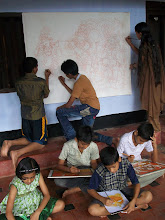composed his classic "KRISHANAGEETHI " in eight chapters, in the style of Jayadeva's (12th century Bengali poet ) GEETHAGOVINDAM.
The Krishnanattam (a mosaic of folk and classic arts), a dance drama, has evolved from this Krishnageethi over 300 years ago. This work deals with the Krishna avatar - from Krishna's birth to his final emancipation from worldly life and ascension to heaven. It is presented in 8 episodes namely 'Avatharam', 'Kaliyamardhanam', 'Rasakreeda', 'Kamsavaddham'. 'Swayamvaram', 'Banayuddham', 'Vividha vadham', and "Swargarohana". These episodes are presented on eight consecutive nights. Since the last story is considered inauspicious, the "Avathara " always follows "Swargarohana" and it will be enacted on the ninth day.
Also visit the following link:
krishnanattam by P K S Raja,Present Zamorin Raja of Calicut
For a critical review of Krishnanattam pl visit:
Theatre and the world: performance and the politics of culture
By Rustom Bharucha on Google Books
The story as depicted in the mural:
*Krishnagiti* was written between 1655 A.D. and 1658 A.D. by the then Zamorin Raja of Calicut , Manavedan. During this period, the renowned Vaishnava Sage Vilwamangalam Swamiyar and the Manavedan were staying at Guruvayur. Vilwamangalam Swamiyar was such an ardent devotee of Bhagavan Guruvayurappan that he could see Bhagavan in flesh and blood whenever he wanted.
Sree Krishna depicted as Guruvayurappan
Sanskrit Scholar and Poet , Manavedan Raja, the Zamorin Crown Prince,
One day requested Bilwamangala Swamiyar to guide him in realising the Bhagavan.
Swamiyar replied that before committing anything he will have to consult Bhagavan Guruvayurappan and get his consent. The next day the Swamiyar told him that Guruvayurappan has given his consent and Manavedan can see Guruvayurappan playing in the early hours of the morning at the platform of the *Elanji* tree.
When as per this agreement, Manavedan saw Guruvayurappan in the form of little child Sri Krishna, he was so excited that he forgot himself and, rushed to embrace little Sree Krishna.
Guruvayoorappan immediately disappeared saying, "Vilwamangalam did not tell me that this will happen ". However, during the melee, Manavedan got one peacock feather from the head gear of Bhagavan Krishna.
King Manavedan became sad for the inadvertent discourtesy shown by him to Bhagavan Sri Krishna . As advised by Vilwamangalam Swamiyar, , he immediately went to the sanctum sanctorum of Bhagavan Guruvayurappan and pledged that with that feather of peacock, he will make a headgear , compose *Krishnagiti* in the form of a dance drama and dedicate it to Bhagavan.
A Moorthy of Sri Krishna was made using the wood of the `Eanji' tree. (The `Elanji' tree stood at the place where now, the Kuttambalam stands, on the south-east side of the sanctum sanctorum of the Guruvayur Temple ). According to the advice of Vilwamangalam, Manavedan composed *Krishnagiti* sitting before that Moorthy with single minded devotion.
The peacock feather was incorporated in the headgear for the character of Sri Krishna. The headgear was found to suit the heads of all actors performing as Bhagavan Krishna. The actor also used to get 'possessed' on wearing this headgear.
Manavedan wrote *Krishnagiti* in eight cantos, and without any assistance did the choreography, all the costume make up including Krishna's headgear, facial make up, details of instruments for the background music and prepared the list of all and sundry articles required for staging the dance drama. He himself selected the artists for the *Arangetam* ( inaugural performance) and trained them to perform the dance drama. It is to be noted that the Arangetam of all the eight plays viz., Avatharam, Kaliyamardanam, Rasakrida, Kamsavadham , Swayamvaram, Banayuddham, Vividavadham and Swargarohanam were performed near the sanctum sanctorum of the Guruvayur Temple. On the ninth day, Avatharam was repeated as the Zamorin felt that it was not auspicious to end the series with the demise of Lord Krishna. This practice of performing Avatharam after Swargarohanam is being continued to this day.



































